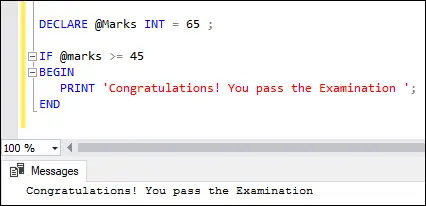Príkaz IF je súčasťou funkcie toku riadenia na serveri SQL Server. Zvyčajne ide o rozhodovacie vyhlásenie v rôznych programovacích jazykoch, ktoré vráti hodnotu na základe daných podmienok . Tento príkaz vykoná kód zapísaný v bloku IF, keď sa daná podmienka vyhodnotí ako pravdivá a keď sa podmienka vyhodnotí ako nepravda, vykoná sa príkaz ELSE.
Vyhlásenie IF
Nasleduje syntax, ktorá ilustruje použitie tohto príkazu v SQL Server:
IF boolean_expression BEGIN { statement_block } END Vo vyššie uvedenej syntaxi je výpis_bloku v ZAČIATOK...KONIEC blok sa vykoná, keď je booleovský_výraz je so stavom spokojný. V opačnom prípade sa tento blok preskočí a ovládací prvok programu sa presunie do príkazu za KONIEC kľúčové slovo. Mali by sme vedieť, že ak výraz obsahuje a SELECT vyhlásenie, musíme vložte ich do zátvoriek .
Príklad
Pozrime sa na príklad, aby sme pochopili príkaz IF bez bloku ELSE. Nasledujúci príklad zobrazí výsledok, keď je podmienka splnená. V opačnom prípade sa ovládací prvok programu presunul na príkaz za kľúčovým slovom END, ak existuje.
DECLARE @Marks INT = 65 ; IF @marks >= 45 BEGIN PRINT 'Congratulations! You pass the Examination'; END
Vykonaním príkazu sa získa nasledujúci výstup:

Teraz to ukážeme na nižšie uvedenom ' študent tabuľka s nasledujúcimi údajmi:

Nižšie je uvedený ďalší príklad, ktorý získa celkové známky vybraného študenta z ' študent tabuľku vo vzorovej databáze a potom vytlačí a správu keď to je viac ako 400 .
BEGIN DECLARE @Total_Marks INT; SELECT @Total_Marks = total_marks FROM Student WHERE age>25; SELECT @Total_Marks; IF @Total_Marks > 400 BEGIN PRINT 'Congratulations! You pass the Examination'; END END
Získame nasledujúci výstup:

Ak chceme vidieť vyššie uvedenú výstupnú správu, mali by sme kliknúť na Správy karta:

Vyhlásenie IF-ELSE
V scenári reálneho sveta musíme vykonať nejakú akciu vždy, keď je podmienka v príkaze IF TRUE alebo FALSE. V tomto prípade je užitočný príkaz IF...ELSE. Tento príkaz vykoná blok príkazu ELSE, keď je podmienka v klauzule IF vyhodnotená ako FALSE.
Nasleduje syntax, ktorá ilustruje použitie príkazu IF ELSE v SQL Server :
IF expression BEGIN Statement block -- It executes when the IF clause expression is TRUE. END ELSE BEGIN Statement block -- It executes when the IF clause expression is FALSE. END
Príklad
Pozrime sa na príklad, aby sme pochopili príkaz IF s blokom ELSE. Nasledujúci príklad zobrazí správu „ Gratulujem! Absolvujete Skúšku “, keď je splnená podmienka IF. V opačnom prípade zobrazte „ Si neúspešný! Nabudúce viac šťastia '.
DECLARE @Marks INT; SET @Marks = 65; IF @marks <45 begin print 'congratulations! you pass the examination'; end else 'you are failed! better luck next time'; < pre> <p>Executing the statement will give the below output. Here, the <strong>marks</strong> variable is <strong>65</strong> , and the <strong>condition (65<45)< strong> is not satisfied. Therefore, the message inside the ELSE block is displayed:</45)<></strong></p> <img src="//techcodeview.com/img/sql-server-tutorials/49/sql-server-if-else-5.webp" alt="SQL Server IF ELSE"> <p>We will get this output because the condition <strong>(65>45)</strong> is satisfied. Therefore, the message inside the IF block is displayed:</p> <img src="//techcodeview.com/img/sql-server-tutorials/49/sql-server-if-else-6.webp" alt="SQL Server IF ELSE"> <p>Now, we will demonstrate the IF ELSE statement on the above ' <strong>Student'</strong> table. In this example, we are going to check whether the student <strong>total marks</strong> is <strong>greater than or equal to 400</strong> or not as follows:</p> <ul> <li>When the IF condition is TRUE, we will get the student records whose total marks are greater than or equal to 550.</li> <li>If the condition is FALSE, we will get the student records whose total marks are less than 550.</li> </ul> <p>Here is the program:</p> <pre> DECLARE @Marks INT; SET @Marks = 600 ; IF @Marks >= 550 BEGIN SELECT id, name, gender, age, total_marks FROM Student WHERE total_marks >= 550 ORDER BY age ASC END ELSE BEGIN SELECT id, name, gender, age, total_marks FROM Student WHERE total_marks <550 order by age asc end < pre> <p>In this code, we have specified the <strong>@Marks</strong> variable to <strong>600</strong> , and the condition (600 >= 550) is satisfied. Therefore, we will get the output where student records whose total marks are greater than or equal to 550 are displayed.</p> <img src="//techcodeview.com/img/sql-server-tutorials/49/sql-server-if-else-7.webp" alt="SQL Server IF ELSE"> <p>If we changed the <strong>@Marks</strong> variable to <strong>500</strong> and the condition (500 >= 550) becomes false. Therefore, we will get the output where student records whose total marks are less than 550 are displayed.</p> <img src="//techcodeview.com/img/sql-server-tutorials/49/sql-server-if-else-8.webp" alt="SQL Server IF ELSE"> <h2>Nested IF ELSE Statement</h2> <p>Unlike other programming languages, we can nest an IF...ELSE statement inside another IF...ELSE statement in SQL Server. Let us demonstrate it with the following example:</p> <pre> DECLARE @age INT; SET @age = 6; IF @age <18 50 print 'you are underage'; else begin if @age < below 50'; senior cetizen'; end; pre> <p>In this example, we are going to check whether the <strong>age is underage, below 50, or senior citizen</strong> as follows:</p> <ul> <li>If the value of the <strong>@age</strong> variable is below <strong>18</strong> , it will print the person is <strong>underage</strong> .</li> <li>If the condition is FALSE, the ELSE part will be executed that has a nested IF…ELSE.</li> <li>If the value of the <strong>@age</strong> variable is under <strong>50</strong> , it will print <strong>below 50</strong> . Finally, if no condition is satisfied, it will print <strong>senior citizens</strong> .</li> </ul> <p>Here is the result:</p> <img src="//techcodeview.com/img/sql-server-tutorials/49/sql-server-if-else-9.webp" alt="SQL Server IF ELSE"> <p>This article gives a complete overview of how to use the SQL Server IF ELSE statement. Here we have learned:</p> <ul> <li>Variables are objects that serve as placeholders.</li> <li>The keyword BEGIN will be used to start a statement block, and the END keyword must be used to close it.</li> <li>The use of ELSE in an IF... ELSE statement is optional.</li> <li>It's also possible to nest an IF...ELSE statement inside another IF...ELSE statement. However, nesting an IF statement within another statement is bad practice because it makes the code difficult to read and maintain.</li> </ul> <hr></18></pre></550></pre></45>
